After writing an article about natural herbicides in the December issue of this newsletter, I was asked what I thought about the iron HEDTA (FeHEDTA) herbicides that recently came on the market. These are organically acceptable products believed to have minimal human health or environmental effects.
My first finding was it’s difficult to obtain herbicides with FeHEDTA in Southern California where I am based, but apparently products are easier to find in Northern California. Of the four nurseries I went to, I found only one that carried even a single product that contained FeHEDTA. The product I found was Whitney Farms Lawn Weed Killer (Scotts), although according to the California Department of Pesticide Regulation’s pesticide product database, there are four other registered products with the same active ingredient (Table 1).
Table 1. California Registered Herbicides containing FeHEDTA.
|
FORMULATION |
COMPANY |
NAME |
% OF ACTIVE INGREDIENT |
|
concentrate |
Bayer |
Bayer Advanced Natria Lawn Weed Control Concentrate |
26.5% |
|
concentrate |
Engage Agro |
Fiesta Turf Weed Killer |
26.5% |
|
concentrate |
Gardens Alive |
Iron-X Selective Weed Killer for Lawns |
26.5% |
|
ready to use |
Scotts |
Ortho Elementals Lawn Weed Killer |
1.5% |
|
ready to use |
Scotts |
Whitney Farms Lawn Weed Killer |
1.5% |
Various sources of information about FeHEDTA state it provides control or suppression of a number of common broadleaf lawn weeds (e.g., dandelion, English daisy, white clover, black medic, common chickweed, and broad-leaved plantain) but won’t injure grasses, making this a selective herbicide for use on lawns.
I did some of my own testing, although not a controlled study, on broadleaf plantain, dandelion, oxalis (creeping woodsorrel) (Figure 1a), and black medic in a tall fescue lawn and on weeds in concrete cracks. It took about one week for broadleaf plantain to die, and there was only foliar damage to black medic (Figure 2). However, both the oxalis and dandelion were showing injury within one day and were controlled in about three days. There was no turf injury.
Figure 1. Oxalis in tall fescue lawn treated with FeHEDTA, one week after treatment (a) and four weeks after treatment (b).
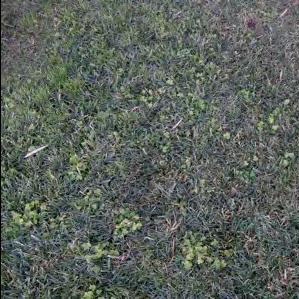
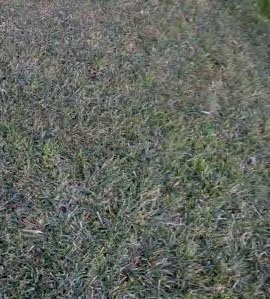
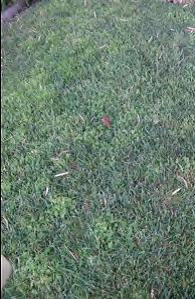
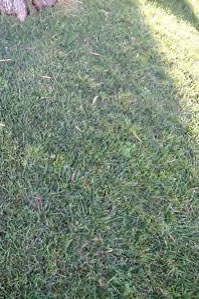
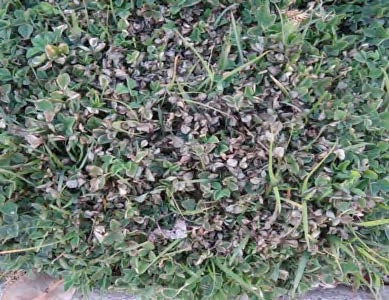
The product also provided good control of oxalis growing in cracks in concrete sidewalks and didn’t stain the sidewalk.
I found that there was no observable difference if the herbicide was applied in the sun or the shade. However, on some weed species, especially black medic, the herbicide didn’t adhere well to the leaf and beaded up, which could explain the lack of good control (Figure 3). More testing is needed to see if use of a surfactant could improve activity.
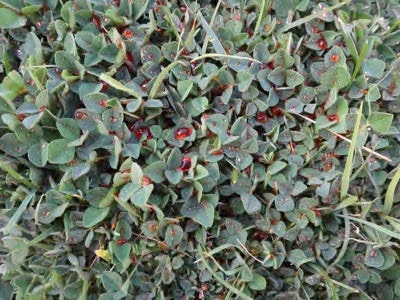
I do want to caution that there is no soil residual. The area I sprayed for oxalis had new plants, although not as many as the untreated section, within about a month after I did the treatment (Figure 1b).
Photos by C.A. Wilen, UC
Original source



An article in the Milwaukee Journal Sentinel by Melinda Myers discusses this product; however, does not address the concentration factors appropriately?
A followup to your question based on some information I received via email from someone who works for the registrant of an iron-HEDTA product.
Dear Dr. Hanson,
My name is xxxxxx xxxxx and I work for Neudorff, a manufacturer and registrant of reduced-risk pesticides. We are the registrant on iron-HEDTA, the chelated-iron selective herbicide evaluated by Dr Wilen. I am writing about the question raised by Mr. Shell to which you replied. These products, consumer, RTU, and the commercial concentrate, called Fiesta, all present some risk of phyto-toxicity to bentgrass and are labeled specifically ‘do not apply to bentgrass’ (http://www.neudorffpro.com/index.php?id=1879).
In a cursory search, it looks to me like most of the HEDTA formulations are premixed and should not be diluted. The labels that I looked as usually said something along the lines of "spray target plant thoroughly" and "do not dilute" the product. Perhaps somebody in Wisconsin can chime in and offer more local experience.
1. It's less effective on weeds with oily leaves, like the black medic mentioned in the article. There needs to be testing to find a suitable and compatible surfactant.
2. Larger weeds may take two or three treatments. Initially, the plant may appear to be dead but new green growth may appear and will need to be treated.
3. It kills morning glories much more quickly than Roundup.
4. The concentrate seems to be difficult to find.
Thank you
I'd be surprised if HEDTA products works well on a perennial plant like celadine. My guess is that, at best, it would be damaged and likely to regrow. Give it a shot and let us know.
Brad
In the labelling on Active-X, or anywhere else I find in a search on FeHEDTA weed-killing preparations, I find no indication of what sort of "Other Ingredients" make up the remaining 73+% of the formula? If it's all H2O, fine. If it includes other things to enhance the weed-suppressing effects, maybe not so fine for my purposes.
Is such information available anywhere?
While I don't have that specific information based on the understanding that this is a systemic poison the danger to bees is likely low to none. That being said you should always observe proper application safety and apply during safe times.
Apply the weed killer at night, early mornings, and in the late evening, which are the times that bees won't be foraging. Between 8 pm and 8 am, the evening applications lead to minimum bee contact with the weed killer.